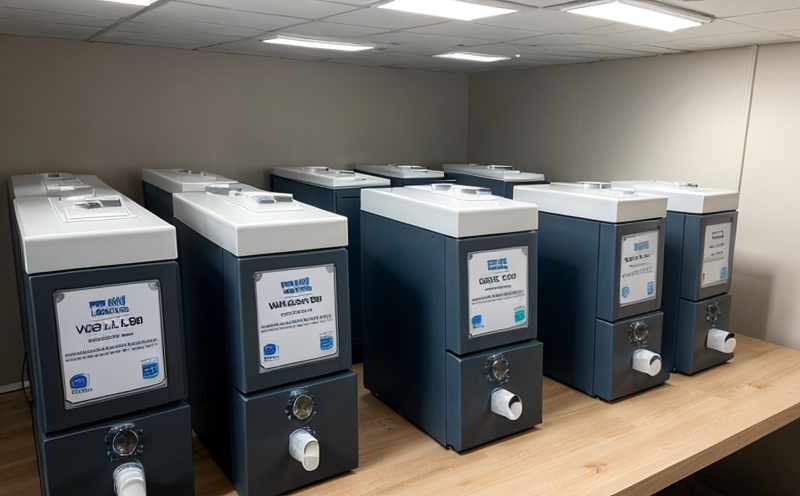ASTM D7706 Determination of aldehydes in indoor environments
The ASTM D7706 standard method provides a robust approach to determining the concentration levels of aldehydes, particularly formaldehyde and acetaldehyde, within indoor air. This service is critical for ensuring that residential, commercial, and industrial spaces meet stringent health and safety standards set by international regulatory bodies such as ISO 12493.
Formaldehyde and other volatile organic compounds (VOCs) are known to contribute significantly to poor indoor air quality (IAQ). Exposure to these compounds can lead to a range of adverse health effects, including respiratory issues, headaches, and allergic reactions. The ASTM D7706 method is widely recognized for its precision in measuring aldehydes, making it an essential tool for maintaining IAQ compliance.
The testing process involves the collection of air samples from the indoor environment using specialized sampling devices. These samples are then analyzed using gas chromatography with a nitrogen-phosphorus detector (GC/NPD) to quantify the presence of various aldehydes. The method is particularly sensitive and can detect even trace levels of these compounds, ensuring accurate readings.
ASTM D7706 outlines several important parameters for specimen preparation and analysis. Specimens are collected over a specific period to ensure an accurate representation of the indoor environment's aldehyde levels. Post-collection, samples undergo rigorous quality control checks before being analyzed using GC/NPD. This ensures that only high-quality data is reported back to clients.
The ASTM D7706 method is widely applicable across various sectors including residential construction, commercial buildings, and industrial facilities. In the context of residential construction, this service helps builders ensure that new homes meet stringent IAQ guidelines. For commercial properties, it ensures compliance with health and safety regulations in office spaces and public areas. Industrial settings benefit from this testing to prevent VOC emissions from adversely affecting worker health.
The ASTM D7706 method is an integral part of the broader effort to enhance indoor air quality across various industries. By adhering to this standard, organizations can ensure that their buildings meet not only regulatory requirements but also exceed expectations in terms of occupant comfort and health.
- High Accuracy: ASTM D7706 ensures precise measurements of aldehyde concentrations, providing reliable data for decision-making.
- Regulatory Compliance: The method aligns with international standards, ensuring that facilities meet legal requirements for IAQ.
- Safety Assurance: By identifying and quantifying volatile compounds, ASTM D7706 helps protect occupants from potential health risks associated with poor IAQ.
The ASTM D7706 service is particularly valuable for quality managers, compliance officers, R&D engineers, and procurement professionals. These stakeholders can leverage the results of this testing to improve indoor environments, enhance product safety, and ensure regulatory compliance across various sectors.
Scope and Methodology
The ASTM D7706 method is designed to determine the concentration levels of aldehydes in indoor air. The standard specifies a detailed procedure for collecting and analyzing air samples using gas chromatography with a nitrogen-phosphorus detector (GC/NPD). This methodology ensures that only high-quality data is reported, making it an essential tool for maintaining IAQ compliance.
The testing process begins with the collection of air samples from the indoor environment. Specialized sampling devices are used to collect these samples over a specific period to ensure an accurate representation of aldehyde levels in the space being tested. Once collected, specimens undergo rigorous quality control checks before undergoing analysis using GC/NPD.
Gas chromatography with nitrogen-phosphorus detection (GC/NPD) is a highly sensitive analytical technique that can detect even trace levels of volatile compounds. This method allows for precise quantification of aldehydes in the air sample, providing reliable data for decision-making.
The ASTM D7706 method specifies several important parameters for specimen preparation and analysis. Specimens are collected over a specific period to ensure an accurate representation of the indoor environment's aldehyde levels. Post-collection, samples undergo rigorous quality control checks before being analyzed using GC/NPD. This ensures that only high-quality data is reported back to clients.
The ASTM D7706 method is widely applicable across various sectors including residential construction, commercial buildings, and industrial facilities. In the context of residential construction, this service helps builders ensure that new homes meet stringent IAQ guidelines. For commercial properties, it ensures compliance with health and safety regulations in office spaces and public areas. Industrial settings benefit from this testing to prevent VOC emissions from adversely affecting worker health.
The ASTM D7706 method is an integral part of the broader effort to enhance indoor air quality across various industries. By adhering to this standard, organizations can ensure that their buildings meet not only regulatory requirements but also exceed expectations in terms of occupant comfort and health.





